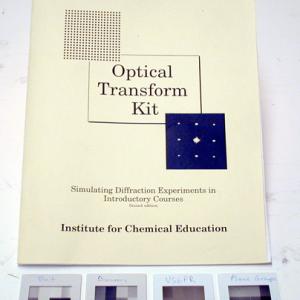College of Liberal Arts & Sciences
7A60.24 - X-ray Diffraction - Optical Analog
An optical analog of x-ray diffraction is to use the slides that have crystal pattern reductions and a laser. Different crystal structures will give different Fraunhofer diffraction patterns.
You can also make your own slides by using a piece of cellophane tape and Lycopodium powder, or letting some microspheres dry on a microscope slide and then hitting them with a laser.
- F. Logiurato, L.M. Gratton, and S. Oss, "Optical Simulation of Debye-Scherrer Crystal Diffraction", TPT, Vol. 46, # 2, Feb. 2008, p. 109.
- Cyril Isenberg, "Laser Diffraction Experiments with Pseudoliquids and Pseudosolids", TPT, Vol. 38, # 7, Oct. 2000, p. 411.
- Se-yuen Mak, "Gratings for Simulation of Laue Crystal Diffraction", TPT, Vol. 32, # 9, Dec. 1994, p. 539.
- Sir Lawrence Bragg, "The History of X-Ray Analysis", TPT, Vol. 3, # 7, Oct. 1965, p. 295.
- Peter Russo, Alfred D. Brothers, "Powder Diffraction Patterns on the Tel-X-Ometer 80", AJP, Vol. 50, # 1, p. 89, Jan. 1982.
- Kathryn D. Burch et al., "Optical Simulation of Low-Energy Electron Diffraction Patterns", Am. J. Phys, 237, Vol. 53, No. 3, March 1985.
- George R. Mitchell, "The Reciprocal Lattice - A Demonstration", AJP, Vol. 46, # 5, May 1978, p. 574.
- Ronald Bergsten, "Optical Crystals", AJP, Vol. 42, #2, Feb. 1974, p. 91.
- Johanna Miller, "Femtosecond Snapshots Capture Atomic Motion in a Powdered Solid", Physics Today, Sept. 2010, p. 13.
- Qun Shen, Quan Hao, and Sol M. Gruner, "Macromolecular Phasing", Physics Today, March 2006, p. 46.
- "Optical Transform Kit", Institute for Chemical Education, University of Wisconsin - Madison.
- Ellis, Geselbracht et al., Teaching General Chemistry: A Materials Science Companion, "Chapter 4: Determination of Structure Using Diffraction Data,", p. 77.
Disclaimer: These demonstrations are provided only for illustrative use by persons affiliated with The University of Iowa and only under the direction of a trained instructor or physicist. The University of Iowa is not responsible for demonstrations performed by those using their own equipment or who choose to use this reference material for their own purpose. The demonstrations included here are within the public domain and can be found in materials contained in libraries, bookstores, and through electronic sources. Performing all or any portion of any of these demonstrations, with or without revisions not depicted here entails inherent risks. These risks include, without limitation, bodily injury (and possibly death), including risks to health that may be temporary or permanent and that may exacerbate a pre-existing medical condition; and property loss or damage. Anyone performing any part of these demonstrations, even with revisions, knowingly and voluntarily assumes all risks associated with them.
